Attached files
| file | filename |
|---|---|
| 8-K - FORM 8-K - ASPEN INSURANCE HOLDINGS LTD | u10686e8vk.htm |
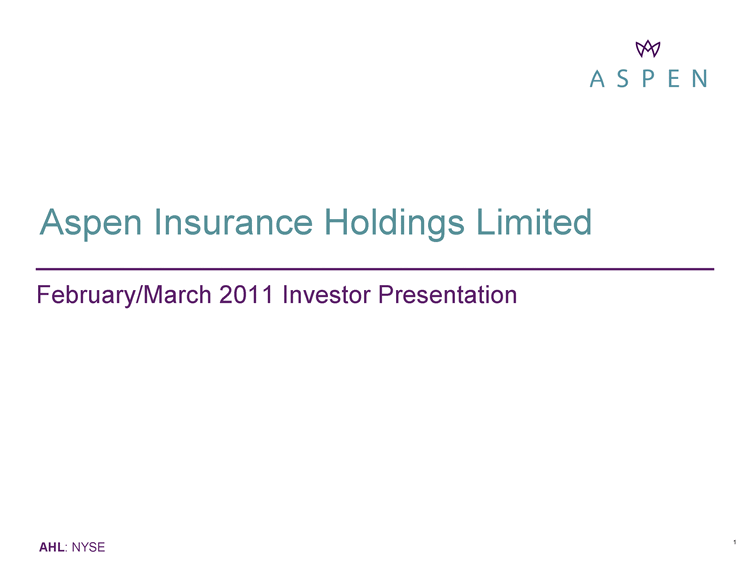
| Aspen Insurance Holdings Limited February/March 2011 Investor Presentation |

| Safe Harbor Disclosure This slide presentation is for information purposes only. It should be read in conjunction with other documents filed by Aspen Insurance Holdings Limited (the "Company" or "Aspen") with the U.S. Securities and Exchange Commission. Non-GAAP Financial Measures In presenting Aspen's results, management has included and discussed certain "non-GAAP financial measures", as such term is defined in Regulation G. Management believes that these non-GAAP measures, which may be defined differently by other companies, better explain Aspen's results of operations in a manner that allows for a more complete understanding of the underlying trends in Aspen's business. However, these measures should not be viewed as a substitute for those determined in accordance with GAAP. The reconciliation of such non-GAAP financial measures to their respective most directly comparable GAAP financial measures in accordance with Regulation G is included herein or in the financial supplement, as applicable, which can be obtained from the Investor Relations section of Aspen's website at www.aspen.bm. Application of the Safe Harbor of the Private Securities Litigation Reform Act of 1995: This presentation contains, written or oral "forward-looking statements" within the meaning of the U.S. federal securities laws. These statements are made pursuant to the safe harbor provisions of the Private Securities Litigation Reform Act of 1995. Forward-looking statements include all statements that do not relate solely to historical or current facts, and can be identified by the use of words such as "expect," "intend," "plan," "believe," "do not believe," "aim," "project," "anticipate," "seek," "will," "estimate," "may," "continue," "guidance," and similar expressions of a future or forward-looking nature. This presentation contains written or oral "forward-looking statements" within the meaning of the U.S. federal laws. These statements are made pursuant to the safe harbor provisions of the Private Securities Litigation Reform Act of 1995. Forward-looking statements include all statements that do not relate solely to historical or current facts, and can be identified by the use of words such as "expect," "intend," "plan," "do not believe," "aim," "project," "anticipate," "seek," "will," "estimate," "may," "continue," "guidance," and similar expressions of a future or forward-looking nature. All forward-looking statements address matters that involve risks and uncertainties. Accordingly, there are or will be important factors that could cause actual results to differ materially from those indicated in these statements. Aspen believes these factors include, but are not limited to: the possibility of greater frequency or severity of claims and loss activity, including as a result of natural or man-made (including economic and political risks) catastrophic or material loss events, than our underwriting, reserving, reinsurance purchasing or investment practices have anticipated; the reliability of, and changes in assumptions to, natural and man-made catastrophe pricing, accumulation and estimated loss models; evolving issues with respect to interpretation of coverage after major loss events; the effectiveness of our loss limitation methods; changes in the total industry losses, or our share of total industry losses, resulting from past events and any intervening legislative or governmental action and, with respect to such events, our reliance on loss reports received from cedants and loss adjustors, our reliance on industry loss estimates and those generated by modeling techniques, changes in rulings on flood damage or other exclusions as a result of prevailing lawsuits and case law; the impact of acts of terrorism and related legislation and acts of war; decreased demand for our insurance or reinsurance products and cyclical changes in the insurance and reinsurance sectors; any changes in our reinsurers' credit quality and the amount and timing of reinsurance recoverables; changes in the availability, cost or quality of reinsurance or retrocessional coverage; the continuing and uncertain impact of the current depressed economic environment in many of the countries in which we operate; the level of inflation in repair costs due to limited availability of labor and materials after catastrophes; changes in insurance and reinsurance market conditions; increased competition on the basis of pricing, capacity, coverage terms or other factors and the related demand and supply dynamics as contracts come up for renewal; a decline in our operating subsidiaries' ratings with S&P, A.M. Best Company, Inc. ("A.M. Best") or Moody's; our ability to execute our business plan to enter new markets, introduce new products and develop new distribution channels, including their integration into our existing operations; changes in general economic conditions, including inflation, foreign currency exchange rates, interest rates and other factors that could affect our investment portfolio; the risk of a material decline in the value or liquidity of all or parts of our investment portfolio; changes in our ability to exercise capital management initiatives or to arrange banking facilities as a result of prevailing market changes or changes in our financial position; changes in government regulations or tax laws in jurisdictions where we conduct business; Aspen Holdings or Aspen Insurance Limited becoming subject to income taxes in the United States or the United Kingdom; loss of key personnel; and increased counterparty risk due to the credit impairment of financial institutions. For a more detailed description of these uncertainties and other factors, please see the "Risk Factors" section in Aspen's Annual Reports on Form 10-K as filed with the U.S. Securities and Exchange Commission on February 26, 2010. Aspen undertakes no obligation to publicly update or revise any forward-looking statements, whether as a result of new information, future events or otherwise. Readers are cautioned not to place undue reliance on these forward-looking statements, which speak only as of the dates on which they are made. In addition, any estimates relating to loss events involve the exercise of considerable judgment in the setting of reserves and reflect a combination of ground-up evaluations, information available to date from brokers and cedants, market intelligence, initial tentative loss reports and other sources. The actuarial range of reserves and management's best estimate represents a distribution from our internal capital model for reserving risk based on our then current state of knowledge and explicit and implicit assumptions relating to the incurred pattern of claims, the expected ultimate settlement amount, inflation and dependencies between lines of business. Due to the complexity of factors contributing to the losses and the preliminary nature of the information used to prepare these estimates and reserves, there can be no assurance that Aspen's ultimate losses will remain within the stated amounts. |

| Contents Investment proposition What we do The Aspen approach Business performance and market outlook Reserves and reserving philosophy US Insurance Australian cat events Guidance Appendices ? Appendix 1: Financial Highlights: Q4 2010 and Full Year 2010 ? Appendix 2: Fixed Income Portfolio by Asset Type ? Appendix 3: Modelled Worldwide Natural Catastrophe Exposures |
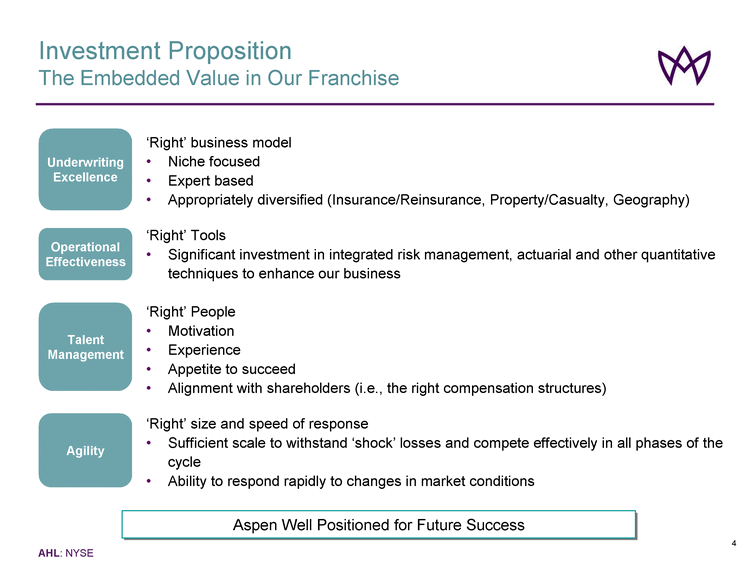
| Investment Proposition The Embedded Value in Our Franchise 'Right' business model Niche focused Expert based Appropriately diversified (Insurance/Reinsurance, Property/Casualty, Geography) 'Right' Tools Significant investment in integrated risk management, actuarial and other quantitative techniques to enhance our business 'Right' People Motivation Experience Appetite to succeed Alignment with shareholders (i.e., the right compensation structures) 'Right' size and speed of response Sufficient scale to withstand 'shock' losses and compete effectively in all phases of the cycle Ability to respond rapidly to changes in market conditions Aspen Well Positioned for Future Success Underwriting Excellence Operational Effectiveness Talent Management Agility |

| Investment Proposition Consistent Growth in Book Value Per Share Over Time (*) Note: See Aspen's quarterly financial supplement for a reconciliation of diluted book value per share to basic book value per share and reconciliation of average equity to closing shareholders' equity in the Investor Relations section of Aspen's website at www.aspen.bm Diluted Book Value per Share up 14% since December 31, 2009 |

| What We Do Return Objective Aim to generate 10 year average ROEs which exceed the 3 year risk free rate by an average of at least 8% with a target of 10.5% Motivated by Shareholder Return and Valuation Aspirations, but Subject to Constraints to Limit Downside Risk Key Features Spread over the risk free rate rather than an absolute value of ROE Time weighted averaging over 10 years rather than the more usual 'over the cycle' ? Reported ROE with an average of 8.5% over the risk free rate since inception* Aim not to fall below 8% Believe that if we perform at higher target level of 10.5%, then more likely to achieve our valuation objective Volatility constraint to limit the chance of an ROE which is 5 percentage points worse than plan to a probability less than 25% * 7 years excluding part year 2002 |

| What We Do Value in the 'Specialty' Approach Value in 'Specialty' Approach Results in Lower Earnings Volatility Combined book (insurance and reinsurance) benefits from diversification between the two risk profiles Probability Insurance Lower average return, less tail risk, more 'normal' distribution Combined Insurance and Reinsurance Reinsurance Higher average return, significant tail, 'skewed' distribution Underwriting profit ($m) -1,750 -1,500 -1,250 -1,000 -750 -500 -250 250 500 750 Disclaimer: The above graph is based on the 2011 January reforecast without adjustment for 2011 actual performance. The risk profile is the result of numerous assumptions within our Economic Capital Model. Results may vary significantly from those shown. Return periods shown relate to total annual net income Underwriting Risk Profiles by Segment (2011e) |

| Return Profile Aligned with Risk Appetite Disclaimer: The above graph is based on the 2011 January reforecast without adjustment for 2011 actual performance. The risk profile is the result of numerous assumptions within our Economic Capital Model. Results may vary significantly from those shown. Return periods shown relate to total annual net income What We Do Risk Profile - As At January 1, 2011 Net Income Median ROE = 11.4% Probability of under-performing mean by 5% or more = 22.4% 1-in-100 ROE = -26% 1-in-250 ROE = -34% -1,500 -1,000 -750 -1,250 -500 -250 250 500 750 1,000 Return ($m) Probability |

| The Aspen Approach Managing Growth Regular Evaluation of Opportunities Consistent with Market Conditions in Accordance with Strict Criteria Hiring of individual underwriters Establishment of new underwriting units ’Bolt on’ acquisitions Transformational M&A Growth Continuum ? ? ? ? Strategic fit Financially attractive Manageable execution risk Consistent with our risk management appetite Key Evaluation Criteria ? ? ? ? |

| '06 '07 '08 '09 '10 The Aspen Approach Investing in our Franchise '03 '04 '05 Specialty RI (Aviation & Marine) US Casualty Re US E&S lines Aviation Insurance Marine Insurance Energy Insurance International Property Facultative Reinsurance Non-US Professional Liability Insurance Excess Casualty Transportation related Liability Insurance Financial & Political Risk Insurance Financial Institutions Insurance Management Technology and Liability Insurance Specie Insurance International Casualty Faculative Reinsurance Credit & Surety Reinsurance Non-US Agriculture Reinsurance US Professional Liability Insurance US Directors & Officers Insurance US Excess Casualty Insurance Bermuda London US Paris Zurich Reinsurance Dublin Lloyd's Singapore Miami Cologne UK Regional Zurich Insurance US Admitted* Products Platforms US based reinsurance lines - Property (including Fac) - Casualty (including Fac) Incremental Expansion into Adjacent Business Lines Consistent with Diversification Strategy and Market Conditions * Expect to be able to write in 48 states by H2 2011 |

| Dividends Capital Management Underwriting & Operating Contribution The Aspen Approach Shareholder Value Creation: Pulling the Financial Levers Efficient Management of Financial Levers Key to Value Creation Shareholder Value Creation 2007- 2010 Value creation 2007 2008 2009 2010 Year Investment Income & Realised Gains / Losses Currency Unrealised Investment Returns Other |

| The Aspen Approach Managing the Cycle * Since inception June 2002 ** Renewal Rate Variation Report (RRV) monitors the change in rate for the risk from one year to the next Proactive Management of Cycle |

| The Aspen Approach Investment Philosophy Likes High quality credit Active management of the investment portfolio Simplicity Input from multiple money managers Focus on total investment return Dislikes High volatility Concentrated 'big bets' Illiquid investments Exclusive focus on income statement Impairment charges Current approach Maintain fixed income credit quality at AA- or better Maintain duration between 2.5 and 3.5 years given outlook for interest rates and the yield curve Maintain current sector allocations; do not "chase yield" in current low rate environment Prepare the portfolio for a rising yield environment; have entered into interest rate swaps, as the fixed payer to mitigate the negative impact of rises in interest rates on the market value of our fixed income portfolio Focus on preservation of book value ? X |

| The Aspen Approach Prudent Investment Management Growth and Stability in Aspen's Book Yield Since 2003 Proactive Management of Investment Portfolio to Build Long Term Value Through all Market Cycles; $240mm in Unrealized Investment Gains at Q4 2010 Consistent investment approach to deliver stable investment income focused on: Credit quality & liquidity Interest rate tactics / hedging Yield curve management |

| 3 Year Total Return* vs. Peers*** 22% 67% 4% 7% 0.2% AAA AA A BBB BIG** The Aspen Approach Delivering Strong Investment Returns Aggregate Investment Portfolio Credit Ratings Outperformance vs. Peers; Aspen Rated #5 Out of 15 $7.3 billion as at end 2010 * Total investment return at September 30, 2010 ** Below Investment Grade is 0.20% of the portfolio *** Peers include ACE, ACGL, ALTE, AWH, AXS, ENH, MRH, PRE, PTP, RE, RNR, TRH, VR, XL |
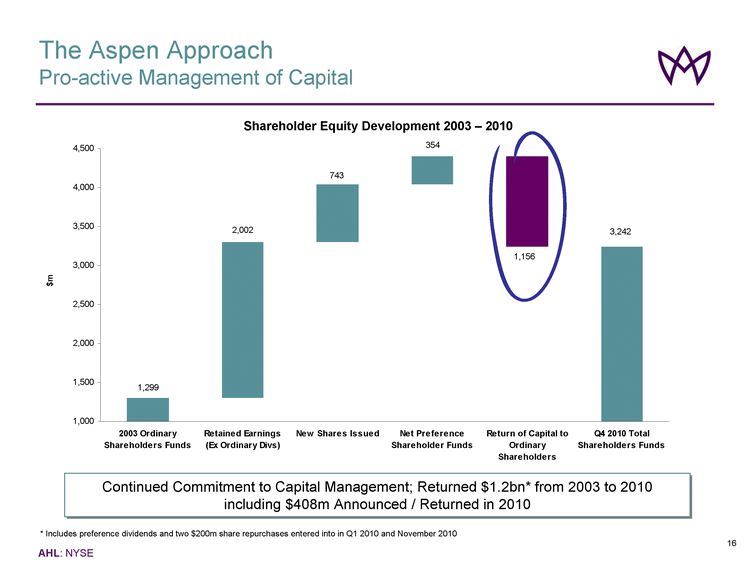
| The Aspen Approach Pro-active Management of Capital Shareholder Equity Development 2003 - 2010 Continued Commitment to Capital Management; Returned $1.2bn* from 2003 to 2010 including $408m Announced / Returned in 2010 * Includes preference dividends and two $200m share repurchases entered into in Q1 2010 and November 2010 $m |

| Business Performance and Market Outlook Q4 2010* ReinsuranceQ1’10Q2’10Q3’10Q4’10Q1’10Q2’10Q3’10Q4’10Q1’10Q2’10Q3’10Q4’10Q1’10Q2’10Q3’10Q4’10Q1’10Q2’10Q3’10Q4’10Q1’10Q2’10Q3’10Q4’10Property Catastrophe ReinsuranceTreaty CatastropheOther Property ReinsuranceTreaty Risk Excess Treaty Pro RataProperty FacultativeCasualty ReinsuranceInternational Casualty TreatyUS Casualty TreatyCasualty FacultativeSpecialty Reinsurance Credit Surety & P olitical Risk RISpecialty ReinsuranceInsuranceProperty InsuranceUK Commercial Property & Construction InsUS Property E&S InsuranceCasualty Insurance UK Liability InsuranceExcess Casualty InsuranceUS Casualty E&S InsuranceMarine, Energy & Transportation InsuranceMEC Liability InsuranceEnergy Property InsuranceMarine Hull Insurance Aviation InsuranceSpecieFinancial & Professional Lines InsuranceFinancial Institutions InsuranceProfessional Lines InsurancePolitical & Financial Risk s Insurance *MEC - Marine, Energy & Construction1 - 12 months rolling RORAC3 - Relative Price Movement for all in-force renewed contracts5 Change in rolling GWP for last 4 quarters vs. rolling GWP from previous 4 qu 2 - Ratio In force Actual to Technical (or modelled) price4 - Terms and Conditions6 - Outlook (Absolute Pricing * Forecast Relative Price Movement)* As at December 31, 2010. Key located on page 44 Performance Absolute Pricing Relative Price Movement Terms & Conditions Volume change Out look * As at December 31, 2010. Key located on page 44 |

| Reserves and Reserving Philosophy Summary As at year end, loss reserves stand at $3.82bn, with $2.1bn of IBNR Reserving philosophy is to maintain a consistent level of reserving strength above a mean best estimate ? Targeting 75th percentile on an undiversified basis for each line of business As at year end, held reserves are set 9.1% ($316m) above the mean best estimate Level of margin has increased since year end 2008 and 2009 Level of margin provides a high degree of confidence that the reserves will ultimately prove sufficient ? As at year end, held reserves are estimated to be at the 88th percentile Historical reserve releases support the appropriateness of our philosophy Robust reserving process and strong reserving governance Intend to publish global loss triangles Q1 / early Q2 2011 Note: Refer to our 2009 annual report on Form 10-K for a discussion of assumptions and uncertainties relating to the Company's reserves |

| Reserves and Reserving Philosophy Consistent Levels of Reserve Adequacy Absolute Level of Reserve Margin Has Increased; Insurance Reserves Moved to a Similar Confidence Interval as Reinsurance Note: Refer to our 2009 annual report on Form 10-K for a discussion of assumptions and uncertainties relating to the Company's reserves |

| Reserves and Reserving Philosophy Confidence in Reserves Overall Reserve Position at 88th Percentile vs. 86% at Year End 2009; Insurance Reserves Moved to a Similar Confidence Interval to Reinsurance (72nd vs. 74th Percentile) Note: Refer to our 2009 annual report on Form 10-K for a discussion of assumptions and uncertainties relating to the Company's reserves As at December 31, 2009$ million Accounted Percentile %10th 25th 75th 90th Reinsurance (total pre diversification)2,069.4 73% 1,540.0 1,698.5 1,895.8 2,078.2 2,281.5 Insurance (total pre diversification)1,261.7 69% 982.8 1,068.8 1,187.6 1,293.7 1,414.5 Diversification 295.81 62.6 0.0 (147.8) (300.5) Group Total Post-Diversification 3,331.1 86% 2,818.6 2,929.9 3,083.4 3,224.1 3,395.5 As at December 31, 2010 $ million Accounted Percentile % 10th 25th 75th 90th Reinsurance (total pre diversification)2,343.8 74% 1,691.9 1,879.5 2,132.4 2,355.2 2,614.2 Me an Best Estimate Insurance (total pre diversification) 7 4767 Diversification 379.7 225.2 0.0 (184.7)(413.8) Group Total Post-Diversification 3,820.5 88% 3,179.6 3,315.6 3,504.3 3,670.4 3,870.1 72% 1,476.7, 72% 1,108.0 1,201.9, 1,371.9 1,499.9 1,669.7 Overall Reserve Position at 88th Percentile vs. 86% at Year End 2009; Insurance Reserves Moved to a Similar Confidence Interval to Reinsurance (72ndvs. 74th Percentile) Source: Aspen Company Data Insurance (total pre diversification) Reinsurance (total pre diversification) Reinsurance (total pre diversification) Insurance (total pre diversification) |

| Reserves and Reserving Philosophy Case and IBNR High Proportion of Reserves in IBNR; Total Reserves Split 54% IBNR / 46% Case * As at December 31, 2010 Insurance Reserves Reinsurance Reserves $1.3bn $1.5bn $2.1bn $2.3bn Case IBNR Case IBNR |

| Reserves and Reserving Philosophy Historical Reserve Releases Favorable reserve development since 2006 2010 has seen less favorable development than previous years As shown in previous slides, this is not as a result of a weakened reserving basis or reduced reserving margins Note: Refer to our 2009 annual report on Form 10-K for a discussion of assumptions and uncertainties relating to the Company's reserves 51.3 107.4 83.5 84.4 21.4 |

| Major re-structuring of US 'Open Market' casualty account under new Head of General Casualty Detailed claims review undertaken Addition of 4 new quality underwriting teams in the US with demonstrable, profitable track records Professional Lines, D & O, Inland Marine / Ocean Cargo, General Casualty US Insurance Key Actions in 2010 Expanded Footprint People Portfolio Re-engineering Infra-structure Addition of admitted capability through purchase of admitted shell company; expect to be able to write admitted business in 48 states by July 2011 Clearly Defined Plan to Restore Profitability; Building a Successful US Insurance Franchise Remains Core Component of Strategy Appointment of John Cavoores as Co-CEO of Aspen Insurance with executive oversight of US Insurance operations (Q3 '10) Significant up-grade and up-skilling of talent in US to support investment in underwriting teams Re-vamped claims, actuarial, HR, IT and operations through key new hires |

| Difficulties in US casualty portfolio emanate from Open Market primary GL* E&S account, especially contractors Open Market primarily GL comprised ca. 75% of total US casualty portfolio ($31m premium in 2010) ? Comprised ca. 70% contractors' business (mainly NY & Western State contractors) ? Contractors' writings peaked in 2009 & decreased in 2010; expected to represent only around 14% (ca. $5m) of the account in 2011 and will exclude NY and Western State contractors and construction wrap business US Insurance US Casualty Reserving Year Reserving Actions Held Reserves of $223m for US Casualty Insurance at End 2010; Increased Margin Held Over Actuarial Mean Best Estimate from 68th to 72nd Percentile 2009 2010 Strengthened 2008 and prior years by $20m following a detailed analysis of NY contractor business ? Review mainly focused on 2007 and prior as 2008 / 2009 years immature Further strengthened 2009 and prior years by $32m (IBNR and case) ? Majority of strengthening on more recent accident years Strengthening resulted from detailed ground-up claims review under new US Head of Claims involving 4 external claims adjusters with specialist expertise ? Included all open claims (333) covering construction and construction defect in any state ? Sample of >25% (or 219) of all other open claims on the account also reviewed ? Reserves now based on probable ultimate cost = a stronger reserving basis * General liability |
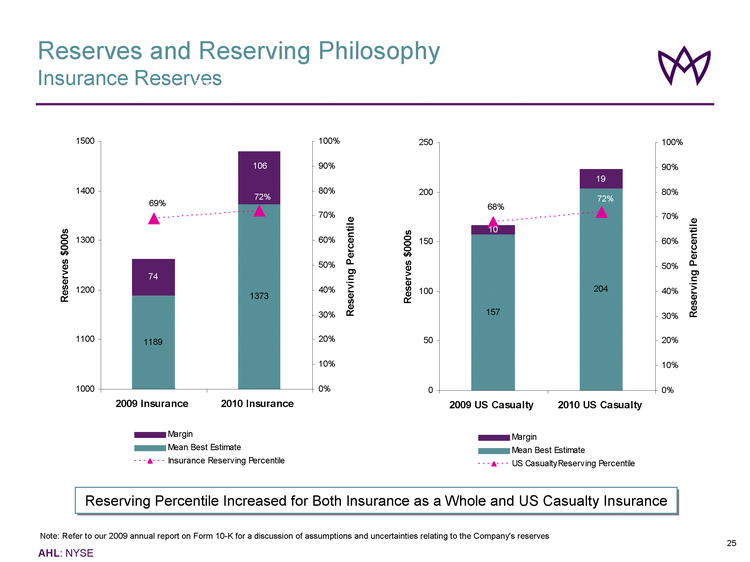
| Reserves and Reserving Philosophy Insurance Reserves Note: Refer to our 2009 annual report on Form 10-K for a discussion of assumptions and uncertainties relating to the Company's reserves 72% 72% 72% Reserving Percentile Increased for Both Insurance as a Whole and US Casualty Insurance 72% |

| Australian Cat Events* Aspen Property Reinsurance 1st Flood Event Central Queensland Dec 24 - 31, 2010 <= $1.5bn => $1-2bn: notable uncertainty on mining losses Losses not expected to be material $0.5bn Losses expected to be less than 1% of estimated market loss No losses expected Approx. $10m, included within Q410 IBNR Insured Market Loss Estimate ICA Reported Claims $0.5 -1bn AIR initial range $0.36 -1.52bn n/a n/a $2-4bn likely to trigger main domestic cat placements. Upper end of range could trigger worldwide placements Aspen's Cat Lines Biased Towards Upper Layers; No Aggregates, Sub-Layers or Frequency Driven Sideways Covers 2nd Flood Event SE Queensland Jan 4, 2011 3rd Flood Event Brisbane Jan 10 - 17, 2011 4th Flood Event Victoria Jan 13, 2011 (ongoing) Cyclone Yasi N Queensland Feb 2, 2011 ICA: Insurance Council of Australia * Note: As at February 8, 2011 Losses expected to be less than 1% of estimated market loss |

| 2011 Guidance Actual 2010 Results Initial Guidance February 8, 2011 Gross Written Premium $2.1 billion $2.1 billion +- 5% % Premium Ceded 9.3% of GEP 8% - 12% of GEP Combined Ratio 96.7% 93% - 98% Tax Rate 8.1% 8% - 12% Cat-Load $181 million $170 million (assuming normal loss experience) |

| Appendices |

| Financial Highlights: Q4 2010 (US$ in millions, except per share data) Quarter Ended December 31 2010 2009 Change Gross Written Premiums 412.8 405.7 1.8% Net Written Premiums 395.2 383.4 3.1% Net Earned Premiums 499.7 476.2 4.9% Underwriting Income 23.2 73.3 (68.3%) Net Investment Income 57.058.2(2.1%) Net Income after Tax 92.7 126.3 (26.6%) Financial Ratios Loss Ratio 61.5%47.8% _Expense Ratio 33.8% 36.9%_ Combined Ratio 95.3% 84.7%_ Annualized Operating ROE * 12.0% 18.8%_ Operating EPS* 1.02 1.44 (29.2%) Diluted Book Value per Share* 38.90 34.14 13.9% (*) Note: See Aspen’s quarterly financial supplement for a reconciliation of operating income to net income, average equity to closing shareholders’ equity and diluted book value per share to basic book value per share in the Investor Relations section of Aspen’s website at www.aspen.bm Appendix 1 |

| Financial Highlights: YTD 2010 (US$ in millions, except per share data) (*) Note: See Aspen's quarterly financial supplement for a reconciliation of operating income to net income, average equity to closing shareholders' equity and diluted book value Year Ended December 3120102009ChangeGross Written Premiums2,076.8 2,067.1 0.5% Net Written Premiums1,891.1 1,836.8 3.0%Net Earned Premiums1,898.9 1,823.0 4.2%Underwriting Income63.1 288.4 (78.1%)Net Investment Income232.0248.5(6.6%)232.0 248.5 (6.6%)Net Income after Tax 312.7 473.9 (34.0%) Financial Ratios Loss Ratio65.8%52.0%_Expense Ratio30.9%32.1%_Combined Ratio96.7%84.1%_Annualized Operating ROE*9.4%18.0%_Operating EPS* 3.03 5.16 (41.3%)Diluted Book Value per Share* 38.90 34.14 13.9% per share to basic book value per share in the Investor Relations section of Aspen's website at www.aspen.bm Appendix 1 |

| Financial Highlights: Group Summary Q4 2010 Casualty Property Marine, Energy and Transportation Financial and Professional Lines Casualty Property Catastrophe Other Property Specialty Appendix 1 |

| Financial Highlights: Group Summary YTD 2010 Casualty Property Marine, Energy and Transportation Financial and Professional Lines Casualty Property Catastrophe Other Property Specialty Appendix 1 |
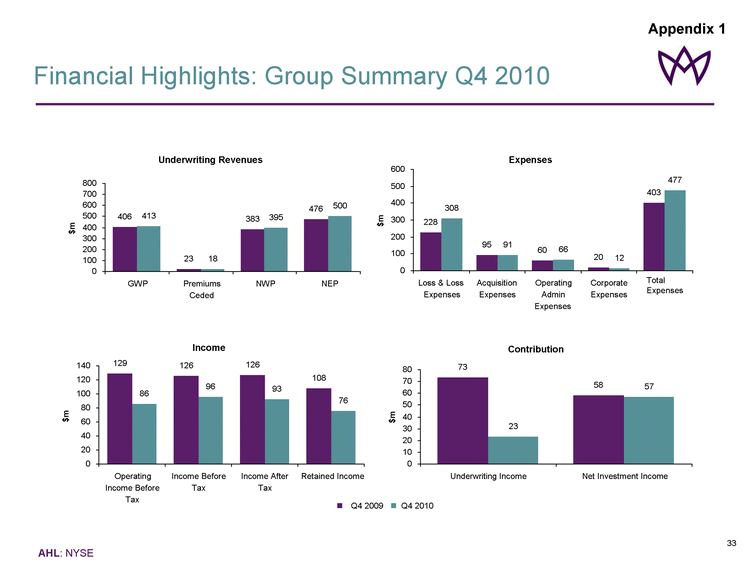
| Financial Highlights: Group Summary Q4 2010 Underwriting Revenues 406 23 383 476 413 18 395 500 0 100 200 300 400 500 600 700 800 GWP Premiums Ceded NWP NEP $m Expenses 228 95 60 20 403 308 91 12 477 66 0 100 200 300 400 500 600 Loss & Loss Expenses Acquisition Expenses Operating Admin Expenses Corporate Expenses Total Expenses $m Income 129 126 126 108 86 96 93 76 0 20 40 60 80 100 120 140 Operating Income Before Tax Income Before Tax Income After Tax Retained Income $m Contribution 73 58 23 57 0 10 20 30 40 50 60 70 80 Underwriting Income Net Investment Income $m n Q4 2009 n Q4 2010 Appendix 1 |

| Financial Highlights: Group Summary YTD 2010 Underwriting Revenues 2,067 230 1,837 1,823 2,077 186 1,891 1,899 0 500 1,000 1,500 2,000 2,500 GWP Premiums Ceded NWP NEP $m Expenses 948 334 199 54 1,535 1,249 328 212 47 1,836 0 400 800 1,200 1,600 2,000 Loss & Loss Expenses Acquisition Expenses Operating Admin Expenses Corporate Expenses Total Expenses $m Income 521 535 474 400 288 340 313 243 0 100 200 300 400 500 600 Operating Income Before Tax Income Before Tax Income After Tax Retained Income $m Contribution 288 249 63 232 0 50 100 150 200 250 300 350 Underwriting Income Net Investment Income $m n YTD 2009 n YTD 2010 Appendix 1 |
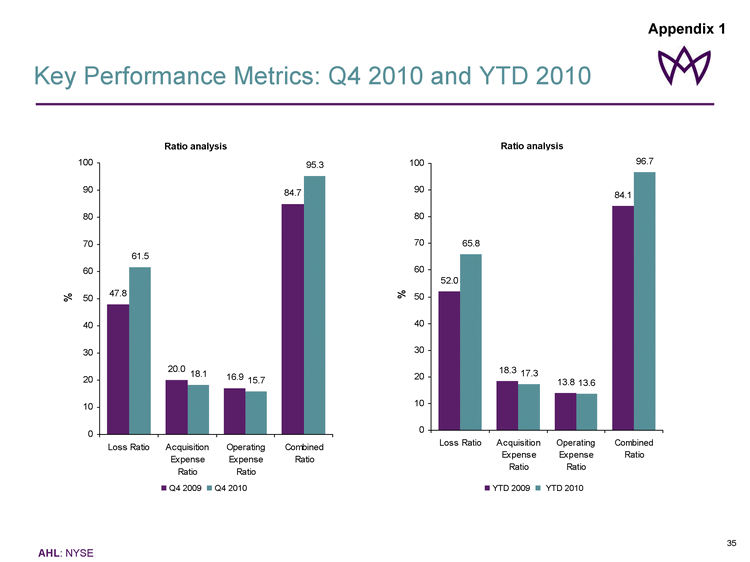
| Key Performance Metrics: Q4 2010 and YTD 2010 n YTD 2009 n YTD 2010 n Q4 2009 n Q4 2010 Appendix 1 Ratio analysis Ratio analysis |

| Results by Business Segment: Q4 2010 (*) Underwriting income is calculated as underwriting revenues, less underwriting expenses n Q4 2009 n Q4 2010 Appendix 1 GWP Underwriting Income* |

| Results by Business Segment: YTD 2010 (*) Underwriting income is calculated as underwriting revenues, less underwriting expenses GWP 1,176 891 1,162 915 0 200 400 600 800 1000 1200 1400 Reinsurance Insurance $m Underwriting Income * 329 (24) 14 134 -40 0 40 80 120 160 200 240 280 320 360 400 Reinsurance Insurance $m n YTD 2009 n YTD 2010 Appendix 1 |

| Key Performance Metrics: Q4 2010 * Reinsurance 82.8% 78.7% (10.9)% (9.7)% 12.6% -20% 0% 20% 40% 60% 80% 100% 120% Q4 2009 Q4 2010 Combined Ratio 71.9% 81.6% Insurance 90.4% 3.1% 6.2% 102.6% 0% 20% 40% 60% 80% 100% 120% Q4 2009 Q4 2010 Combined Ratio Prior Year Adj. AY Combined Ratio (excl. Cats) Catastrophe Losses Prior Year Adj. AY Combined Ratio 108.8% 93.5% Total 90.7% 91.0% (6.0)% (3.1)% 7.4% -20% 0% 20% 40% 60% 80% 100% 120% Q4 2009 Q4 2010 Combined Ratio Prior Year Adj. AY Combined Ratio (excl. Cats) Catastrophe Losses 95.3% 84.7% * Catastrophe losses from the New Zealand and Chile earthquakes have been removed from the accident year combined ratios for comparative purposes Appendix 1 |

| Key Performance Metrics: YTD 2010 * Catastrophe losses from the New Zealand and Chile earthquakes have been removed from the accident year combined ratios for comparative purposes Prior Year Adj. AY Combined Ratio (excl. Cats) Catastrophe Losses Prior Year Adj. AY Combined Ratio (excl. Cats) Catastrophe Losses Prior Year Adj. AY Combined Ratio Appendix 1 |

| Financial Highlights: Total Investment Return - Q4 2010 58.2 7.5 (33.1) 29.3 57.0 10.5 (54.6) (3.3) (122.1) -150 -120 -90 -60 -30 0 30 60 90 Net Investment Income Realized Investment Gains Other-Than- Temporary Impairment Charges Movement in Unrealized Investment Gains/Losses Total Investment Return $m Q4 2009 Q4 2010 _ Appendix 1 |

| Financial Highlights: Total Investment Return - YTD 2010 Annualized Investment Return for the Year to Date of 4.8% 248.5 34.6 118.2 232.0 50.9 53.9 336.5 (23.2) 378.1 -50 0 50 100 150 200 250 300 350 400 Net Investment Income Realized Investment Gains Other-Than- Temporary Impairment Charges Movement in Unrealized Investment Gains/Losses Total Investment Return $m YTD 2009 YTD 2010 (0.3) Appendix 1 |

| Fixed Income Portfolio by Asset Type (US$ in millions) (US$ in millions) ASSETS: INVESTMENT PORTFOLIO DECEMBER 31, 2010 TOTAL INVESTMENT PORTFOLIO AT MARKET VALUE7,265.4Cash, Short-Term Securites and FOHFGovernment/AgencyStructured SecuritiesUnsecured Credit Short-term Securities289.7 773.7 Asset-backed securities U.S. Government 63.7 Corporate bonds 1,810.0 Cash and Cash Equivalents1,179.1 302.8 1,172.5 125.8 Agency Rated Mortgage-backed securities (GNMA, FNMA, FHLB)FDIC Guaranteed Corporate bondsAgency Deben tures OtherInvestments(IrisRe)Other Investments (Iris Re) Foreigngovernment 6263 Non-Agency Rated Mortgage-backedsecuritiesForeigncorporates501.0 - CMBS128.1 228.7 - RMBS- 34.0 Municipal bondsBonds backed by foreign government Q4 20101,498.8 1,702.8 1,364.3 2,699.5 Q3 20101,242.5 1,785.4 1,374.2 2,803.5 Q4 20091,159.3 1,430.9 1,551.9 2,615.2 ASSETS: INVESTMENT PORTFOLIO DECEMBER 31, 2010 Appendix 2 |

| Aspen's Modelled Worldwide Natural Catastrophe Exposures - Major Peril Zones Source: Aspen analysis using RMS v9.0 occurrence exceedance probability as at January 1, 2011 and Shareholders' Equity of $3,241.9 million 1 in 100 Year Tolerance: 17.5% of Total Shareholders' Equity 1 in 250 Year Tolerance: 25% of Total Shareholders' Equity Appendix 3 |

| Business Performance and Market Outlook: Key Key Performance Absolute Pricing Relative Price Movement Terms and Conditions Volume change Outlook Key 1 2 3 4 5 6 Excellent Excellent Significantly Up Excellent Significantly Up Excellent Good Good Up Good Up Good Satisfactory Satisfactory Flat Satisfactory Flat Satisfactory Of Concern Of Concern Down Of Concern Down Of Concern Unsatisfactory Unsatisfactory Significantly Down Unsatisfactory Significantly Down Unsatisfactory Appendix |
